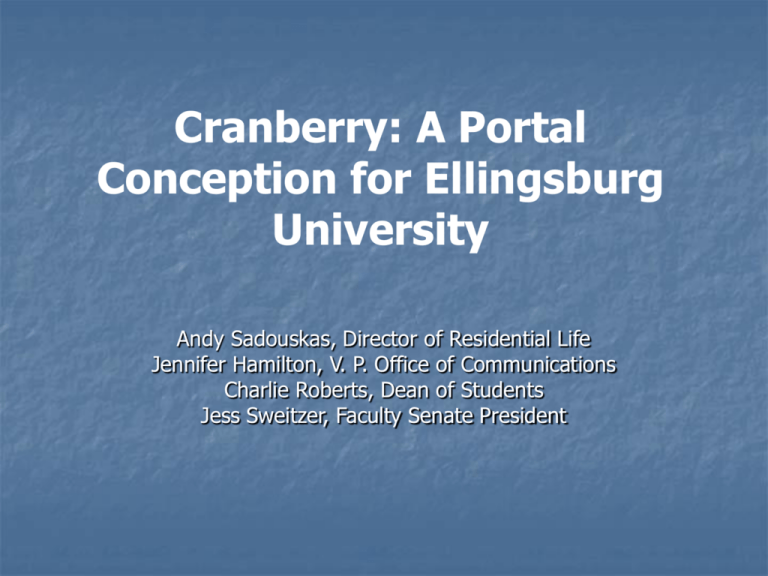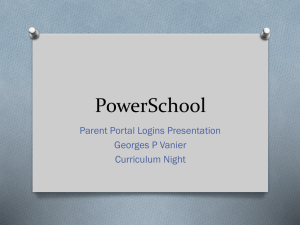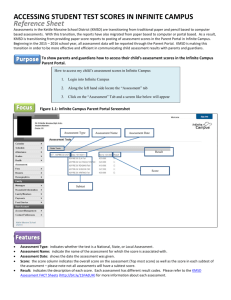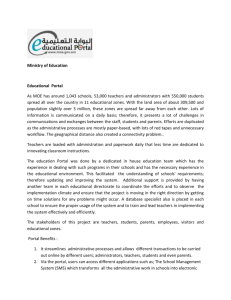OhioUniversity - StudentAffairs.com
advertisement

Cranberry: A Portal Conception for Ellingsburg University Andy Sadouskas, Director of Residential Life Jennifer Hamilton, V. P. Office of Communications Charlie Roberts, Dean of Students Jess Sweitzer, Faculty Senate President Introduction Members of the President’s executive staff, thank you for having us today. This presentation introduces our proposal for a customized portal. The first twothirds is focused on answering the first five of seven questions posed to us by the new Technology Director. Introduction (cont.) This is followed by question number six and an actual mock up of the proposed portal, “Cranberry.” The presentation concludes with a listing of “good practice” sites and pertinent literature/references in answer to question number seven. Why a customized portal and not just use the university web presence? Customized Portal vs. Web Presence At Ellingsburg University we are in the process of revamping our current campus technology systems. As part of this effort our committee has been charged with developing a portal. This decision was made based on a review of pertinent literature that explains why institutions are choosing portals over their current web presences. The next few slides contain quotes from the literature that support the decision to replace our current web presence with a portal. Customized Portal vs. Web Presence (cont.) “Portals facilitate the discovery of people, organizations, and content in a meaningful context. Portals are secure, offering user authentication, credential mapping and sensitive data encryption. Portals are personalized, proactively providing customized desktops based on the user’s role to the community” (Ethridge, Hadden & Smith, 2000, p. 13). “If you want to help students succeed, you must involve them in active, personal, and meaningful learning that appropriately supports their development within an inclusive, collegial, and empowering educational community” (Harr, 2002, p. 10). Customized Portal vs. Web Presence (cont.) “Our task, as student development educators, is to design our systems and procedures in ways that challenge and empower students to learn while providing the appropriate degree and elements of support. In terms of information system design, this would mean front-loading support with easy-to-use tools and directly accessible resources while encouraging students to take an active and self-responsible role in their own educational endeavors” (Harr, 2002, p. 10). “…we learn that on a typical day, 26 % of college students use some type of instant messenger. These data suggest students are active Internet users, computers are already integrated into their lifestyle and communities, and they are already creating their own virtual campuses” (Barratt & Potts, 2002). Customized Portal vs. Web Presence (cont.) “Put simply, an ins1titution’s portal is designed to make an individual’s web experience more efficient and thereby make the institution as a whole more productive and responsive” (Looney & Lyman, 2000). “At the most basic level, portals gather a variety of useful information resources into a single, ‘one-stop’ Web page, helping the user to avoid being overwhelmed by ‘infoglut’ or feeling lost on the Web” (Looney & Lyman, 2000). “Most simply put, a student portal is a personalized, student-centric view of College Web resources” (Harr, 2002, p. 5). Portal Customization Portal users can change... Font Backgrounds Color Scheme Calendar Information What portal channels do we recommend and why? Portal Channels Check grades Drop/Add courses Class schedules Course registration View/Print unofficial transcripts Check degree requirements Admissions information Check status of admission application Academic advisor information Current faculty office hours Student organization information Athletics information View/Pay bill Portal Channels (cont.) Residence hall room selection Review and accept/deny financial aid award package Check e-mail Library services Directory services Health and Wellness services Student code of conduct/Judicial information Dining hall information Computer services Payroll forms Career services Alumni/ae services Portal Channels (cont.) Customized calendar Announcement board Chat rooms Course management tools Administrator-specific functions Disability services Multicultural Affairs LGBTQA student services African-American student services Latino/a student services Native American student services Asian-American student services International student services Portal Channels (cont.) Human Resources Job opportunities Benefit package Online job application Automatic book ordering system Parking information Purchase parking permits online Parking maps Online parking ticket payment Orientation registration and information Online campus tour Campus map Information Technology online help services Institutional Research Campus safety Academic support services Portal Channels (cont.) The aforementioned portal channels were chosen based on a review of the pertinent literature, those included in “good practice” sites, and personal recommendations. The following slides include quotes from the literature that support our portal channel choices. Portal Channels (cont.) “…enable campus organizations (for example, clubs or interest groups, students or faculty government associations, fraternities/sororities, etc.) to distribute content, communicate and collaborate, and deliver surveys to their membership through an online environment similar to the course sites with which they are already familiar” (Blackboard, Inc., 2004). “When integrated with student information system, class schedules, exams and other academic information can be placed on the calendar” (Volchock, 2000). Portal Channels (cont.) “Faculty can send announcements to all students in a particular class. Through e-mail commerce interfaces, book lists for each class can be posted and links to the campus bookstore or external bookstores can be provided” (Volchock, 2000). “…containing information and University announcements; a student, faculty, and staff recognition area; personalized calendar; popular news media outlets; and a searchable directory” (Conway & Hubbard, 2003). “…containing the University value statements, student handbook, code of conduct, and judicial procedure” (Conway & Hubbard, 2003). Portal Channels (cont.) “…simplifies course enrollment with sample class schedules, class key-word searches, and access to require class enrollment dates” (PeopleSoft, 2004). “Technology needs to be developed in students affairs in the same way it is developed in other areas of the university community. Not only should the delivery of financial aid applications, admissions applications, housing and registration be done via the Internet, other forms of support for students should be available through this mechanism as well….One advantage of this system is that it is accessible twenty-four hours a day, seven days a week” (Blimling & Whitt, 1999, pp.187188). Portal Channels (cont.) “No two college portals are alike, although most provide a core of common student services. Students typically can register, drop or add courses, look up their grades, and check on what courses they need to complete their degree requirements. Most colleges see Webbased e-mail systems and individual course schedules as other “must have” portal services, both for students, and faculty members. Beyond offering those basic portal services, colleges can distinguish themselves with extras” (Olsen, 2002, p. A32). Recommendations for who (what types of people) should be appointed to detailed planning and implementation teams. People If this portal concept is accepted, we believe that the people who are involved in further planning teams, should be the same people that are then involved in the implementation of the portal. This works towards avoiding gaps in information that can occur between planning and implementation teams. The following slide contains our recommendations for areas that should have representation on these planning and implementation teams. People (cont.) Residence Life Financial Aid Registrar Bursar Judicial Affairs Student Affairs/Services Athletics Communications and Public Relations Development Institutional Research Academic Support Human Resources Information Technology Admissions Library Faculty Chief Academic Officer Chief Financial Officer Students Alumni/ae Health and Wellness Services Academic Deans Career Services People (cont.) “Making a decision on a university-wide portal system, and ensuring the coordinated implementation of such a system, requires early interdepartmental participation and ongoing collaboration” (Frazee, 2001, p. 46). “The development of a student portal will require close collaboration of technical experts, content experts, students, and administrative leadership” (Harr, 2002). People (cont.) “…portals become more mainstream, student affairs professionals need to be involved in the institutional decisions regarding which platform to adopt. The use of portals will change the way student activities and residence life promote their events, the manner in which campus communication takes place, the interaction between students and faculty/staff, and the interaction between students themselves” (Volchock, 2000). People (cont.) Gilbert (2000) recommends including the following people/areas: Chief Academic Officers, Faculty, Students, Student Affairs, Development, Library, Technology Support, Disability Support Services, Alumni, Registrar, Academic Department Chairs, and Assessment. Eisler (2001) recommends the following people: Chief academic officer, Dean or department chair, Faculty, Academic support professionals, Chief information officer, IT support professionals, Library, Student Services, Students, Bookstore (p. 14). How do we propose to get feedback on what goes in the portal and how it should be organized? Feedback Student focus groups including student government, residence hall sections, student organizations, and student athletes. Faculty and staff focus groups. Note: Focus groups will be conducted during both planning and trial implementation periods. Campus wide surveys. Meetings with campus Information Technology professionals. What technology-based systems need to be able to communicate using the portal? Technology-Based Systems According to Eisler (2001), the following systems are necessary portal components (p. 5): Intranet Student record system Human resource system Financial record system Collaboration user tools Electronic mail Public information Campus information Library Course management tools Technology-Based Systems (cont.) “A portal must, by definition, tie together existing information systems” (Frazee, 2001, p. 47). A single sign-on of user ID and password will be used, along with a time-based security function. “The single sign-on ultimately delivers more than just ease of use” (Mickool, 2004). “The need for privacy, security and ease of use must be balanced” (Frazee, 2001). Technology-Based Systems (cont.) “In providing access to personal information, access to personal university information, campus portals encounter the same risks as other elements of the campus network. Portals face denial of service attacks, Web alteration, fraud, and identity theft. They must also support network-level security, encryption, and sessionmanagement, and authentication to safeguard sensitive information and prevent unauthorized access” (Eisler, 2003). Technology-Based Systems (cont.) “...Unicode support that will enable customers to maintain data and user interfaces in virtually any language through a single database...Unicode support will allow customers to use languages with non-Western character sets such as Arabic, Japanese, and Thai with their existing database. With support for all international character sets, higher education customers can now view and maintain student, faculty and staff data in any language, enabling a truly global implementation” (PeopleSoft, 2004). How are we planning to organize the portal pages? Ellingsburg University Ellingsburg University Est. 1890 Connect to your Cranberry Portal! 1100 Rolling Hills, Botonia Maryland * telephone: 653-345-4545 * fax: 653-998-8695 * e-mail: Ellingsburg@eu.edu sadouska Future Students “The single sign on ultimately delivers more than just ease of use….A final area that requires Faculty/Staff significant thought and research is session Alumni appropriate time out management and sessions….This gives the user time to think and Community write thoughtful responses to e-mails. However, Hamilton Hall, a home for many first year students financial aid information remain displayed on a screen for more than a few minutes when there is no activity. An integration framework for session Cranberry Campus Portal, 2005 management” ( Mickool, 2004). Students Current Students Cranberry Campus Portal Ellingsburg University Welcome to Cranberry, Andy Sadouskas! Est. 1890 Calendar function, which will automatically have your class schedule, student organizational Ellingsburg News and Events meetings, campus events, Skating tonight…. athletic events, and other items Your laundry is done depending on the campus groups E-mail you join! You need to fill out your FASFA… “For example, it is reported that Calculus canceled… students at Dartmouth College, Cranberry Announcement Board a campus of 8,000 students, to receive faculty, and staff, send allows 25,000students emails daily” ( Strange &information about billing, when laundry is done, campus Banning, 2001, p. 188).their Academic Services Campus Services events, professors, and various other sources daily…all depending on the interest of the individuals. Financial Services Library Services Cranberry Services Community Involvement Directory Welcome to Cranberry, Andy Sadouskas! Ellingsburg University Academic Services Est. 1890 Academic Advisor Check your grades Course Offerings Degree Audit University Catalog Courses Tools Portal Home Campus Services Community Services Financial Services Class Schedule Register for Classes Transcripts Library Services On-line Directory Cranberry Services Prospective Students Cranberry Campus Portal Welcome to Cranberry, Jess Swiezter! Ellingsburg University Est. 1890 Ellingsburg News and Events Ellingsburg is ranked in the top 10 liberal arts institutions according to the U.S. News & World Report…. Senior Jennifer Hamilton has won the a national chemistry award… Received Admissions application on January 12, 2005… Waiting on transcripts… Cranberry Services Admissions Application Campus Services Community Involvement Financial Services History & Tradition Admissions Staff Faculty/Administrators Cranberry Campus Portal Ellingsburg University Welcome to Cranberry, Dr. Dafina Stewart! Est. 1890 Ellingsburg News and Events New Chemistry Professor… Fish and Fries, Caesar salad … You need to fill out your I-9 form… Cranberry Services Student Council meeting at 8 p.m… Academic Services Campus Services Community Involvement Human Resources Financial Services Library Services Administrator Directory Alumni/ae Cranberry Campus Portal Ellingsburg University Welcome to Cranberry, Charlie Roberts! Est. 1890 Ellingsburg News and Events Class 0f 1999 Five year reunion… Dr. Bob Young has won the Nobel Peace Prize… Alumni/ae trip to the Ellingsburg Art Museum with the president… Cranberry Services Homecoming Weekend Alumni/ae Photo Album Alumni/ae Magazine Career Services Make a Donation Community Involvement Alumni/ae Directory Prospective Employees Cranberry Campus Portal Welcome to Cranberry, Jennifer Hamilton! Ellingsburg University Est. 1890 Ellingsburg News and Events Class 0f 1999 Five year reunion… Dr. Bob Young has won the Nobel Peace Prize… Alumni/ae trip to the Ellingsburg Art Museum with the president… Resident Director application received on January 12, 2005… Reviewing applications… Cranberry Services Application Job Opportunities Campus Information Benefits Academics Directory Identify any pertinent literature and give examples of “good practice sites” and different models of campus portals. “Good Practice” Sites PAWS – Louisiana State University (Ethridge, Hadden, & Smith, 2000) Campus Pipeline – Santa Barbara City College (Serban & Fleming, 2002; Pickett & Hamre, 2002) Artemis – Florida Community College at Jacksonville (Harr, 2002) “Good Practice” Sites INSITE – Indiana University One1Stop - Brigham Young University More information More information Other examples of university portals can be found at: http://www.wcet.info/projects/laap/resources/collab_sites.asp#portals Different Models The following are some organizations that provide portal design services: PeopleSoft Campus Pipeline More information Blackboard More information More information uPortal More information Works Consulted Barratt, W. (2003). Information technology in student affairs. In S. R. Komives, & D. B. Woodard Jr., (Eds.), Student services: A handbook for the profession (pp.379-396). San Francisco, CA: Jossey-Bass. Barratt, W. & Potts, C. (2002). Where is the virtual campus union? Student Affairs Online, 3 (4), from http://studentaffairs.com/ejournal/Fall_2002/virtualcamp usunion.htm Blackboard, Inc. (2004). Blackboard community system. Retrieved February 17, 2005, from http://www.blackboard.com/docs/AS/Bb_Community_Sy stem_Brochure.pdf Works Consulted (cont.) Conway, J., & Hubbard, B. (2003, July 26). From brick to bytes: Building an online activities environment. Student Affairs Online, 4 (3). Retrieved February 13, 2005, from http://studentaffairs.com/ejournal/Summer_2003/Bricksto-Bytes.htm Eisler, D. L. (2001). Campus portals: Supportive mechanisms for university communication, collaboration, and organizational charts. Journal of Computing in Higher Education, 13(1), 3-24. Eisler, D. L. (2001). Selecting and implementing campus portals. Syllabus, 14, 22-25. Works Consulted (cont.) Eisler, D. L. (2003, May 1). Campus portal security: Access, risks, and rewards. Syllabus. Retrieved February 15, 2005, from http://campustechnology.com/print.asp?ID=7625 Ethridge, R. R, Hadden, C. M & Smith, M. P. (2000). Building a personalized education portal: Get a behindthe-scenes look at LSU’s award-winning system. Educause Quarterly, 23(3), 12-29. Frazee, J. P. (2001). Charting a smooth course for portal development. Educause Quarterly, 24(3), 42-48. Works Consulted (cont.) Gilbert, S. W. (2000, August 17). Portal decisions demand collaboration – can portals support it? TLT Group. Retrieved February 15, 2005, from http://www.tltgroup.org/gilbert/SyllabusCol2.htm Harr, G. L. (2002). Connections: A comprehensive student portal. Jacksonville, FL: Florida Community College at Jacksonville. (ERIC Document Reproduction Service No. ED474411) Johnson, K. (2001). A river runs through it: Considerations and issues when evaluating student portals. Student Affairs Online, 2 (1), from http://studentaffairs.com/ejournal/Winter_2001/river2.ht m Works Consulted (cont.) Looney, M., & Lyman, P. (2000). Portals in higher education. Educase. Retrieved February 15, 2005, from http://www.educause.edu/pub/er/erm00/articles004/loo ney.pdf#search='portals%20in%20higher%20education %20looney%20and%20lyman Mickool, R. (2004, April 1). The challenge of single signon. Syllabus. Retrieved February 15, 2005, from http://www.campus-technology.com/print.asp?ID=9194 Olsen, F. (2002, August 9). The power of portals. The Chronicle of Higher Education, pp. A32-A33. Works Consulted (cont.) PeopleSoft. (2004). PeopleSoft announces Campus Solutions 8.9. Retrieved February 15, 2005, from http://www.peoplesoft.com/corp/en/news_events/news/ database/press_release.jsp?doc=4E3F54EBD56B669488 256F3400564F12 Pickett, R. A. & Hamre, W. B. (2002). Building portals for higher education. New Directions for Institutional Research, 13, 37-55. Serban, A. M. & Fleming, S. (2002). Evaluation of Campus Pipeline, Spring 2002. Santa Barbara, CA: Santa Barbara City College. (ERIC Document Reproduction Service No. ED476335) Works Consulted (cont.) SunGard Data Systems. (2004). SCT Luminis product family packed offerings. Retrieved February 15, 2005, from http://www.sctcorp.com/Education/products/p_l_index.h tml# Timecruiser Computing Corp. (2005). CampusCruiser: A complete web-based higher education enterprise portal. Retrieved February 15, 2005, from http://www.campuscruiser.com/cc_what_over.html Volchok, D. J. (2000). Student affairs and technology: An introduction to the integration of dot.coms and student affairs. Student Affairs Online, 1 (3), from http://studentaffairs.com/ejournal/Summer_2000/portals .htm Members of the President’s executive staff, thank you for reviewing our portal proposal. We look forward to your decision.






